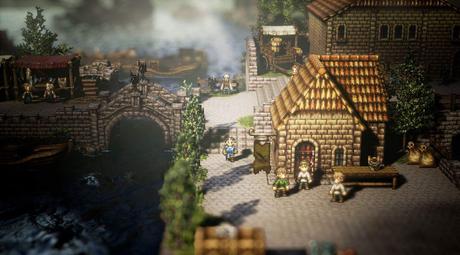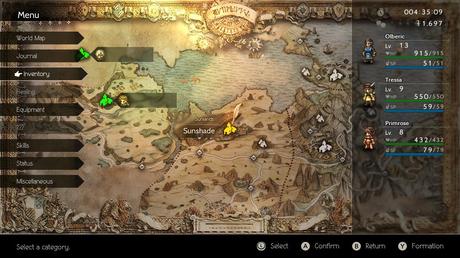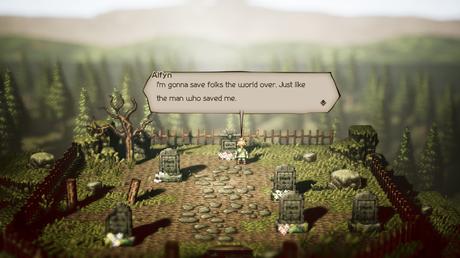There was a time back in the late 80s and early 90s in which role-playing games hadn’t quite reached the level of narrative complexity we know and love today. Unless you were a fan of text-based adventures in the vein of Zork, your average RPG adventure would be more of a linear and narrative-light dungeon crawler like Pool of Radiance. Make a party, head out for the killing fields, and level up your characters until you get to the last boss for one big, climactic showdown.
Octopath Traveler both acknowledges the tradition of combat-oriented games with a more modern twist; Instead of traveling through one light linear story, you travel through eight stories at once. It may sound daunting at first, but the game’s unique narrative approach actually misses the mark more often than it hits. Coming from veteran RPG developer Square Enix, that’s actually something of a surprise.
Eight stories, no divergence

Fulfilling the promise of eight wildly different stories running side-by-side is the sort of game design focus that can throw off even the most talented of scriptwriters. Ensuring the story’s timeline meets up in logical and satisfying ways means tweaking plot elements and carefully balancing a ratio of story to gameplay that, at its core, sounds promising. It’s actually fairly disappointing that Octopath chooses to treat its eight paths like eight separate games that only meet at the mechanics level. That hasn’t stopped fans of the game from clambering over their favorite storyline, of course.
Your ragtag band of adventurers all have their own reasons for striking out on their own. Some of their stories position moral dilemmas for their protagonists to solve; For example, the group’s apothecary is left in the moral gray area of their responsibility to heal a known criminal and whether or not they should feel obligated. Meanwhile, the group’s merchant has a more lighthearted story centred around growing as a salesperson. On their own, these basic plots could grow to be something better than the sum of their parts, yet the game’s approach to storytelling will likely leave you more disoriented than immersed.
The core issue rests in how the game’s storylines are split into four chapters per story, leaving you with 32 individual chapters to play through, yet these chapters are gated by standard RPG level progression on a per-character basis. You won’t be able to play through a single character’s story linearly without stopping to grind for hours on end and you’re much more likely to simply switch to a different character to advance their tale when you hit one of these artificial walls.
In a perfect world, the game’s story would be written in such a way that the level walls simply meant it was time to switch to another character to experience how their story tied into the overarching narrative, but that’s literally never the case. You’ll never get to find out why the group’s thief and not one but two relatively upstanding party members decide to travel together without a single quibble over their chosen paths in life.
Gameplay to the rescue

It might sound like Octopath Traveler has the short end of the stick with how much focus has been poured into the narrative; It is a role-playing game, after all, and that implies at least a hint of care should be put into the story, which it seems to be somewhat lacking in. Yet what it lacks in a gripping narrative it more than makes up for with a classic JRPG-style combat system that offers more depth than many of its ancestors could only dream of.
Built on the classic trope of two turn-based teams beating each other senseless until one side runs out of HP, Octopath stands head and shoulders above classic RPG fare by introducing three core concepts to its combat system: Weaknesses, Breaks, and BP.
Weaknesses are essentially as they sound: Each enemy you encounter is weak to certain types of attacks and those weaknesses are revealed once they take a hit from the appropriate damage source. Each blow taken from a source they’re weak to takes them one step closer to a Break, denoted by a special counter. Knock an enemy’s Break counter down to zero and they’ll be stunned for a round, leaving them open to your entire team and strategically removing them from combat for a cycle.
It’s the kind of system that appeals to those with an appreciation of tactics-heavy combat without becoming overwhelming. Weaknesses are simple to understand and the system doesn’t bog down your decision-making, it simply adds a layer of depth by ensuring you mix up your team’s equipment and attack patterns to get the most out of combat.
The BP system is just the cherry on top, allowing characters to spend BP to either charge up an attack or strike multiple times in the same turn. Choosing to use multiple attacks to quickly stun an opponent or deciding to hold off on depleting one’s BP in order to strike harder after a stunning blow helps take Octopath Traveler a step further from its RPG roots without totally diluting what makes a classic turn-based combat system.
If anything, the game’s combat system takes it above what would otherwise be a very disappointing RPG experience. If the story doesn’t appeal it may still be worth looking into Octopath for the combat alone, especially if you haven’t quite had enough of turn-based strategising in the past few months. The Nintendo Switch has been thin on enticing classic RPGs to fill out its roster and this is a surprisingly solid offering, story aside.
The art of presentation

Seeing as the game obviously holds its JRPG predecessors in high regard, the art direction for Octopath Traveler is appropriately sprite-based, though the game’s environments are presented in a 2.5D style with fully rendered 3D backgrounds occupied by sprite-based characters. It’s not a new approach and its effectiveness really depends on the viewer. In some cases, character sprites wind up difficult to distinguish aside from the main party members, though larger monsters and encounters offer enough visual appeal to help push those worries aside.
The environments themselves aren’t that spectacular, however, especially when combined with the layout of the world you’ll be exploring. Many chapters, if not all of them, are guilty of having a town hub followed by a fairly linear dungeon to tromp through with a few branching paths to explore for optional treasure. Classic approaches to dungeon design may feel nostalgic, but it’s hard not to feel slightly claustrophobic when you’re being funnelled down pathways nearly as restrictive as Final Fantasy XIII’s infamous hallways.
Speaking of Final Fantasy, the game’s soundtrack takes a great many cues from the orchestrated soundtracks found in Square Enix’s repertoire. Battle at Journey’s End is the kind of tune that immediately sets up the emotional reaction you’d expect from a boss battle theme, while the main theme conjures up the kind of feeling only an adventure story can capture. It’s like an adventure in song form and it’s somehow both soothing and exciting all at the same time, like any good fairy tale should be.
How you feel about Octopath as a whole probably depends on how you feel about strategic turn-based combat and heavily trope-laden storytelling that refuses to leave its set paths. For some, that seems to be part of the appeal, but it still feels like the story’s writers missed plenty of opportunities to flesh out some of these ages-old tropes by fostering more interesting character interaction. It’s a game with plenty to enjoy for JRPG fans, but its insistence on sticking to old ways might lead you to burn out halfway through the grinding process.

